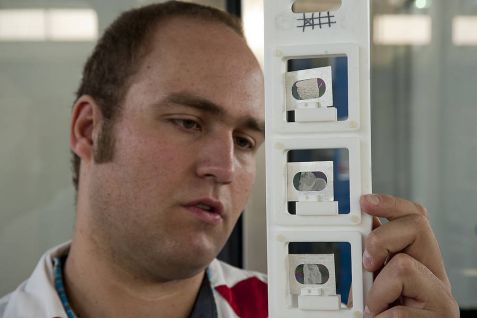MLZ is a cooperation between:
 > Technische Universität München
> Technische Universität München > Helmholtz-Zentrum Hereon
> Helmholtz-Zentrum Hereon
 > Forschungszentrum Jülich
> Forschungszentrum Jülich
MLZ is a member of:
 > LENS
> LENS > ERF-AISBL
> ERF-AISBL
MLZ on social media:

MLZ (eng)
Lichtenbergstr.1
85748 Garching
19.07.2011
Neutrons show distribution of antidepressant in human brain
A physicist of the Technische Universitaet Muenchen has examined tissues using neutrons at the FRM II and found, that the antidepressant lithium is more dominant in some areas of the human brain than others.

Josef Lichtinger examining the tissue, that were measured at the PGAA beam at the FRM II. (Photo: W. Schürmann / TUM)
This suggests, that lithium has a different effect than synthetic psychotropic drugs. The tissue was examined at the neutron source FRM II using a specially developed detector. The aim of the doctoral thesis is to map the distribution of lithium in the human brain, as well as in healthy and depressive patients, to lead to a better understanding of the effect of lithium on the human mind.
Contact:
Dipl. Phys. Josef Lichtinger
Physik-Department
Lehrstuhl E12
Technische Universität München
Email: Josef.Lichtinger@ph.tum.de
MLZ is a cooperation between:
 > Technische Universität München
> Technische Universität München > Helmholtz-Zentrum Hereon
> Helmholtz-Zentrum Hereon
 > Forschungszentrum Jülich
> Forschungszentrum Jülich
MLZ is a member of:
 > LENS
> LENS > ERF-AISBL
> ERF-AISBL
MLZ on social media:


